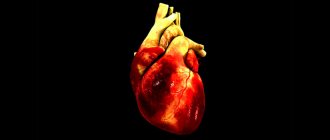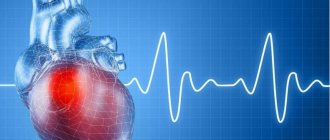September 3, 2010
Doctors are confident that a special diet can improve blood circulation and cope with the first signs of heart disease.
The heart is the only muscle in the body that works continuously and pumps blood, which supplies nutrients and oxygen to the entire body. How effectively it will work also depends on what we eat. Doctors are confident that the nutritional system developed a long time ago called “diet No. 10” can improve blood circulation and cope with the first signs of heart disease.
Basic principles of nutrition for cardiovascular diseases:
1. Eliminate foods that excite the nervous system from your diet
.
Firstly, there is caffeine and caffeinated drinks: cocktails, energy drinks and even all kinds of colas. They increase the heart rate, further loading the heart muscle. Doctors include strong tea, rich broths and dishes containing large amounts of spices as stimulating foods. 2. Reduce your intake of animal fat
.
Fatty foods of animal origin - canned meat, pork, fatty poultry, all types of offal, sausages, smoked meats and lard - are rich in harmful cholesterol, which is deposited in blood vessels in the form of plaques. They can disrupt blood flow, including in the vessels that supply the heart itself. But there is still room on the menu for lean veal, rabbit, chicken and turkey. Boil, steam or bake - any cooking method that does not add additional fat will do. 3. Reduce the amount of salt in your diet
.
This will reduce the amount of fluid that is retained in the body and reduce the load on the heart, which is forced to pump an increased volume of blood. High blood pressure, in particular, develops due to fluid retention. Try to avoid pickles and marinades, and do not buy ready-made sauces, smoked meats and sausages. For the same reason, it is better to avoid fast food, snacks and processed foods, which often have a high salt content. 4. Add Omega-3 fatty acids to your diet
.
These beneficial substances help reduce cholesterol levels in the body, prevent the process of blood clots and lower blood pressure. Omega-3 is most abundant in vegetable oils and fish oil. Experts recommend choosing not too fatty fish and seafood. It is best to boil them, but you can also fry them without fat. But salted, smoked and canned fish are harmful to the heart due to excess salt content. 5. Eat small meals
. In heart disease, a full stomach and bloating lead to irritation of the autonomic nerves responsible for the functioning of the heart. And this, in turn, leads to interruptions in its work. Doctors believe that 4-5 small meals during the day will be easily digested and will not create additional stress on the nervous, and, therefore, cardiovascular system.
Changes in the body and principles of diet
Atherosclerosis and hypertension are the main causes of heart attacks and strokes. What changes occur in the body during the development of cardiovascular diseases?
Increased pressure “wears out” the walls of blood vessels. They become more dense. Aneurysms (expansion of the lumen) occur; the wall in these places becomes thinner and can easily “rip” when blood pressure fluctuates.
The process of formation of atherosclerotic plaques on the walls of blood vessels begins already in infancy, but their size and stability depend on age, lifestyle, and hereditary characteristics. The trend towards a negative attitude towards cholesterol is already a thing of the past, but the stereotype that “it’s better without it” is still alive. Endocrinologists say that about 85% of cholesterol circulating in the blood is synthesized in the body by liver cells and only about 15-20% comes from outside.
Fats are not only a “filler” for cholesterol plaques, but also a material for the construction of all cell membranes and hormones. These are vitamins and natural protection of internal organs from displacement (shock absorption), and the person himself from hypothermia. This means that a complete abstinence from animal foods may not improve, but worsen, your health. But what can be changed? You can influence the amount and composition of fats entering the body.
Speaking about damage to the walls of blood vessels during hypertension and atherosclerosis, we must remember the proteins collagen and elastin. They are responsible for their firmness and elasticity, the smoothness of the inner layer of the vascular wall. The development of atherosclerosis leads to the fact that the walls of blood vessels become more rigid, blood flow decreases, and the heart “has” to put in more effort to push through the required volume. Blood supply deteriorates, the load on the heart increases. The process of restoration of the vascular wall is associated not only with a sufficient amount of protein in food, but also with the presence of ascorbic acid, which takes part in the synthesis of its body structures.
The body needs carbohydrates, first of all, as a quick way to replenish energy. But the excess amount of sugars does not “go away”: they become material for fats. A person’s weight increases, and along with it, the load on the heart increases.
According to the latest WHO recommendations, the amount of table salt (or sodium chloride) that a person receives per day should not exceed 5 g. A larger amount leads to edema and increased stress on the heart. Unfortunately, people are accustomed to considering only the contents of a salt shaker as salt. They forget that sodium chloride can easily “hide” in mayonnaise, ketchup, a piece of sausage, or even in cream cheese.
Having listed the changes that occur in tissues, we can say that the diet for the heart and blood vessels must meet the following requirements:
- Supply the body with all nutrients.
- Do not go beyond the recommended daily caloric intake.
- Prevent fluid retention (edema).
- Contain a minimum amount of “harmful” fats.
- Provide the body with enough protein.
Vitamin therapy, the intake of minerals and trace elements are justified only in cases where the diet does not provide them with food in sufficient quantities.
Potassium and magnesium deserve special attention: these ions have a beneficial effect on the heart and “calm” the nervous system. This means that you need to take care to include foods rich in them in your diet.
Diet No. 10 - do's and don'ts
| Can | It is forbidden |
| Dietary salt-free bread, toast, white bread croutons | Fresh bread, pancakes, pancakes, baked goods |
| Vegetable soups with cereals, milk soups | Broths from meat, poultry, fish, mushrooms. Soups with legumes |
| Lean beef, veal, rabbit, chicken, turkey. Boiled or baked without fat | Fatty meat, geese, ducks, offal, sausages, smoked meats, lard and corned beef, canned meat |
| Lean fish and seafood - boiled or steamed | Fatty fish, salted, smoked fish, caviar, canned fish |
| Milk, low-fat cottage cheese, yogurt, kefir | Salty and fatty cheese, sour cream, cream |
| Soft-boiled eggs, omelettes. No more than 1 egg per day | Fried eggs, hard-boiled eggs |
| Cereal dishes, pasta made from durum flour | Legumes |
| Boiled and baked vegetables. Raw vegetables rarely and carefully | Pickled, salted vegetables. Radishes, onions, garlic, mushrooms, radishes, green peas, cabbage |
| Fresh ripe fruits and berries, honey, jam, dried fruits | Fiber fruits, chocolate, cakes |
| Weak tea, fruit and vegetable juices | Natural coffee, cocoa, strong tea, alcohol |
| Vegetable oils, occasionally unsalted butter | Cooking fats and margarines, lard |
Tags:
- Heart and blood vessels
- Diets
- Caffeine
- Nervous system
- Cellulose
- Therapeutic diets
• To leave a comment you must be an authorized user
- RashaDi In a word - all natural. It’s precisely in semi-finished and processed foods that there is a huge amount of cholesterol and trans fats that accumulate in the body, increase fat deposits, and negatively affect the functioning of the cardiovascular system. I order Atheroclefit Bio on the website phytomarket.ru and take it as a course. The composition is natural, for example, dioscorea extract, supports the health of blood vessels, cleanses their walls of bad cholesterol.
- senezh _Bu__, only your attending physician can advise you on diet and measures to treat your bradycardia. We will not advise you anything here in absentia.
- _Bu__ Question to the specialists representing the site - on “Diet No. 10 - do’s and don’ts”: 1. Why can’t fresh vegetables be allowed? - it would seem that everyone knows that this is healthy food, take it and eat as much as you like. 2. In the same place - why not legumes, mushroom broths, fatty fish, fish broths? (does this refer to ear by the way?) 3. How hard to toast regular black rye bread to make toast in a standard toaster? (minute scale-roller) 4. What is the diet and necessary measures for blood pressure 114\64, pulse 64-69? Bradycardia?
- helluva why can’t legumes and fruits with coarse fiber?
- lastmac without salt our body will die, we need salt
- BUKA_ I’ve been on this diet for about 2 weeks... I'm used to eating without salt... =)
- I liked Colorized 5 basic principles, they are generally doable. But diet No. 10 is very strict, I will start following this if something really hurts, but it’s unlikely to be used as a preventive measure. I’m not yet ready to give up raw vegetables, chicken soup, onions, mushrooms, cheese, beans, salmon.
What not to eat, according to diet No. 10
For diseases of the cardiovascular system, it is necessary to limit as much as possible the consumption of table salt and liquid (up to 5 glasses per day), as well as animal fats . Diet therapy for cardiovascular diseases does not recommend consuming meat and mushroom soups, broths, fried meat and fish, caviar, fatty pickles, and legumes in the diet. Foods containing a lot of cholesterol are also excluded from the diet - liver, brains, kidneys, as well as any spicy and fatty foods, smoked meats, sausages, mushrooms, baked goods, chocolate, cakes, spices, hot seasonings. Among vegetables, it is not recommended to eat onions, garlic, sorrel and radishes. As for drinks, you should not drink strong coffee, cocoa, tea, or carbonated drinks.
Example of dietary table No. 1
As an example of a therapeutic diet, consider dietary table No. 1. It is designed for patients with diseases of the gastrointestinal tract, its goal is a moderate chemical, mechanical and thermal effect on the gastrointestinal tract, a positive effect on inflammatory processes, healing of ulcers, etc.
General recommendations.
The diet involves limiting foods that strongly stimulate gastric secretion (secretion of gastric juice), irritating the mucous membrane, and also excludes difficult-to-digest foods. Consumption of very cold and hot foods is unacceptable; table salt is allowed in moderation. Meals are split, 5–6 times a day. Dishes should be boiled, steamed, baked. Hard foods need to be ground.
Authorized products.
Dried wheat bread made from premium flour, white crackers, dry biscuit, savory biscuits, fresh non-acidic cottage cheese, non-acidic kefir, yogurt, curd dishes: baked cheesecakes, lazy dumplings, puddings, soups with weak vegetable broth, pureed vegetable soups (except cabbage), lean meat (beef, rabbit, turkey and chicken), boiled tongue and liver, lean fish, some cereals: semolina, buckwheat, oatmeal, rice, vegetables only in cooked form: potatoes, beets, cauliflower, sweet varieties of fruit and berries, can be in the form of jelly, mousse and jellies, drinks: diluted tea (with milk or water), weak juices, rosehip decoction.
Prohibited products.
Products that cause gas formation and bloating (white cabbage, legumes), canned food, marinades, smoked meats, lard, fatty meat, garlic, turnips, radishes, horseradish, spices, sauces and seasonings, rich meat, fish and mushroom broths, fresh onions and green onions, parsley, dill, spinach, fresh baked goods and pastries, sour juices and fruits, alcohol, strong tea and coffee, sweet carbonated drinks.
Proper preparation and adherence to a healthy and therapeutic diet will not only bring comfort to the patient’s life, but will also contribute to a speedy recovery and restoration of the body.
Share:
(0 ratings; article rating 0)
General principles for choosing a diet
Despite the fact that each diet is individual, they are all selected taking into account the main factors:
- the needs of each specific organism.
Depending on the ongoing disease and its consequences, each organism needs its own set of nutrients, vitamins and macroelements. Based on the indicators of each specific case, the doctor selects the necessary diet; - taking into account the features of various products.
Each of them differs in its nutritional value, is absorbed differently in the body, and has its own effect on any disease. Therefore, it is important to take into account not just KBJU, but also the chemical composition of a particular product; - the right way to cook.
A weakened body needs strength to recover from an illness, so meals in a therapeutic diet should require a minimum amount of energy for digestion. This can be achieved using special cooking methods. As a rule, special nutrition involves the consumption of boiled, steamed and baked foods. Particularly dense foods are ground or overcooked.
Diet "table No. 10"
The purpose of the diet is to improve blood flow through the vessels of all organs and systems, as well as normalize metabolism.
General characteristics of table No. 10
- Reducing calories by reducing fat and carbohydrate intake.
- Limiting the amount of salt
- Limiting the amount of liquids (tea, coffee)
- Limiting foods that excite the cardiovascular and nervous systems, as well as irritate organs such as the liver and kidneys (coffee, strong tea, chocolate, fatty, spicy, fried foods).
- Increasing the content of products (wheat bran, green peas, cucumbers, avocados, carrots, parsley, spinach, apples, watermelon, kiwi, melon, etc.) that contain potassium and magnesium to nourish the heart or prescribing certain medications by a doctor (cardiomagnyl, etc. )
- Culinary technology for preparing dishes with moderate mechanical gentleness. Meat and fish are boiled. The food temperature is normal.
- The diet is 5-6 times a day, meals are fractional.
Approximate diet
For diseases of the heart and blood vessels, you should follow diets numbered 10, 10A, 10C and 10I. They provide a basic diet and nutritional principles that can be adjusted to suit your taste preferences. Here is a sample list of dishes:
- breakfast. 100 gram portion of steam omelette or cottage cheese with sour cream, or a similar amount of porridge with milk, a glass of tea;
- lunch. Fresh or baked apple, orange;
- dinner. 200 grams of lean soup, 150 grams of lean meat or poultry (boiled). You can serve stewed vegetables as a side dish, and for dessert there is some fruit (100 grams);
- afternoon tea Several crackers or 2-3 unsweetened biscuits, natural fruit juice or jelly, or rosehip tea (200 ml);
- dinner. 150 grams of boiled fish with a side dish of stewed cabbage (100 grams). From drinks you can choose herbal tea or compote;
- 2 hours before going to bed, you can eat some prunes or dried apricots, or limit yourself to a glass of fermented milk drink (for example, kefir).
People suffering from cardiac diseases are recommended to consume no more than 200 grams of bread (preferably rye) per day. As for sugar, its norm is 35 grams.
According to nutritionists, a heart patient needs to consume the following amount of BJU per day:
- protein - 85 grams. Of this amount, 45 grams should come from animal products, and the rest from plant foods;
- fat - 80 grams (50 grams of animal origin and 30 grams of vegetable origin);
- carbohydrates - 350 grams.
At the same time, the total recommended caloric intake for a person with cardiac diseases is 2200-2400 kcal per day.








